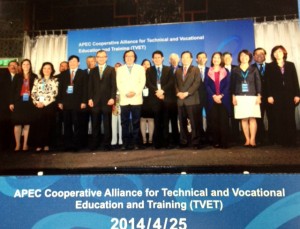It’s not that kids aren’t “college material,†but that the bachelor’s degree is increasingly immaterial
Recently, Michael Petrilli of the Thomas B. Fordham Institute kicked up a lot of attention with his piece on why we should be telling more kids that they aren’t college material.
Central to his argument was that career technical education (CTE) – or teaching and learning that provides students with the academic, technical and employability skills they need to access the careers of their choice – is a more viable option than a four-year degree for many, and one in which we should be counseling more students.
On this point, I agree with Petrilli 100 percent. CTE is one of the best kept secrets out there. Students taking CTE sequences are more likely to graduate high school (at rates upward of 90%, well above the national average) because they find value in the authenticity and relevance CTE brings to their learning.
CTE students are also more likely to go on to “college,†with 75% of graduates who took at least three CTE courses enrolling in postsecondary education within two years. They have the added advantages of real-world experience from work-based learning and career exploration opportunities, and have unique access to mentors and resources to help them chart their future beyond the traditional college prep counseling.
On top of that, completers of CTE postsecondary programs are more likely to be employed than those completing an academic-focused program. Eighty-six percent of postsecondary students completing an associate’s degree in a CTE field of study, for example, are still employed five years later, compared to 78.6 percent of those completing an associate’s degree in an academic field of study. They are filling the skills mismatch, and not fast enough for many employers in the health services, manufacturing and IT sectors.
To summarize, CTE keeps students in school and puts them on a pathway to success. Yay CTE! CTE for all!
So, what’s the problem?
My problem is this: While I appreciate positive attention for CTE, I believe Petrilli did CTE a major disservice with his piece. By setting up CTE as the option for students who are not “college material†he ultimately undermined the value CTE has for all students. And, perhaps more importantly, he reinforced the image problem the CTE community has to deal with every day: CTE remains the place you put kids who just can’t make it to college.
As long as CTE is framed as the non-college option, rather than a pathway to a broader set of college options, we are perpetuating CTE as an inferior, rather than an equally viable (and more reliable), choice.
Despite a decade of efforts to raise the rigor and quality of CTE programs by anchoring them in 21st century knowledge and skills and building stronger linkages between secondary and postsecondary programs through dual/concurrent enrollment, early college programs and other mechanisms, CTE is still not something many parents want for their kids. The stigma of old-school “voc-ed†is a hard one to shake.
So allow me to reframe the discussion. Instead of talking about CTE as being solely for those who can’t be successful in four-year programs, let’s talk about how we can break our country’s addiction to (and reverence for) the bachelor’s degree.
As Petrilli clearly lays out, the notion that a four-year degree is the only option is at best outdated and at worst sets up false expectations for too many students (as evidenced by high remediation, low degree completion and increasing debt). It no longer makes sense to put all of our eggs in the four-year basket. There are many other postsecondary pathways that lead to a family-sustaining wage, job security and mobility that are not being presented as a realistic option to enough of today’s students, and therefore, not being taken advantage of enough.
It is incumbent upon us to encourage more students to engage in these opportunities. And when I say more students, I don’t just mean poor or minority students, but also suburban or higher-income students who go on to a four-year degree because that’s just how it’s done in their communities, regardless of their actual career interests. We need to redefine college so technical colleges, community colleges and the other postsecondary institutions don’t continue to get the short shrift in the minds of parents, students and policymakers.
Finally, we need to flip the system so “career†comes before “college.†Students’ career aspirations should dictate their postsecondary pathways rather than the other way around. It’s not easy, it’s not clean – in fact, it’s a paradigm shift – but it’s what it’s going to take to get our economy back on track and all students their shot at the American dream.
Kate Blosveren, Associate Executive Director
 Sometimes called “the next disrupter†in education, open badges offer an innovative platform for recognizing and displaying a students’ competency demonstrated either inside or outside the traditional classroom. Yet questions remain about how badges work at the institution and state level, how they can be folded into existing education systems, and what it takes to ensure their quality, reliability and validity.
Sometimes called “the next disrupter†in education, open badges offer an innovative platform for recognizing and displaying a students’ competency demonstrated either inside or outside the traditional classroom. Yet questions remain about how badges work at the institution and state level, how they can be folded into existing education systems, and what it takes to ensure their quality, reliability and validity.

 And did I mention the meeting was in Anchorage, Alaska as a bonus? As evidence, here’s a picture of me…and a picture of a moose.Â
And did I mention the meeting was in Anchorage, Alaska as a bonus? As evidence, here’s a picture of me…and a picture of a moose. 


 On the second day of my trip, I had the opportunity to visit two models of technical institutions, the Chinese Culture and Social Welfare Foundation Vocational Training Center (CVTC) and Chung Gang University of Science and Technology (CGUST). CVTC is a privately-run, publicly-subsidized institution that provides training (ranging from 300-900 hours) to unemployed individuals in areas such as culinary arts, gardening/landscaping, webpage design and computer maintenance.  CVTC is one of 13 public training centers in Taiwan – and was the first training center established over 50 years ago. Like most other training centers in Taiwan and the other Asian countries represented at this conference, CVTC provides on-site certifications. (See a map of their campus to the right)
On the second day of my trip, I had the opportunity to visit two models of technical institutions, the Chinese Culture and Social Welfare Foundation Vocational Training Center (CVTC) and Chung Gang University of Science and Technology (CGUST). CVTC is a privately-run, publicly-subsidized institution that provides training (ranging from 300-900 hours) to unemployed individuals in areas such as culinary arts, gardening/landscaping, webpage design and computer maintenance.  CVTC is one of 13 public training centers in Taiwan – and was the first training center established over 50 years ago. Like most other training centers in Taiwan and the other Asian countries represented at this conference, CVTC provides on-site certifications. (See a map of their campus to the right) CGUST, on the other hand, is a private four-year institution that provides training for health care professionals through its College of Nursing and College of Human Ecology. This campus features state-of-the-art simulation equipment, an on-site kindergarten class run by students and staffed by nurses (who also happen to be instructors), and one of the highest placement rates for its graduates.  All students participate in professional internships during summer breaks and about 87% pass their professional certification, which is twice Taiwan’s national average.
CGUST, on the other hand, is a private four-year institution that provides training for health care professionals through its College of Nursing and College of Human Ecology. This campus features state-of-the-art simulation equipment, an on-site kindergarten class run by students and staffed by nurses (who also happen to be instructors), and one of the highest placement rates for its graduates.  All students participate in professional internships during summer breaks and about 87% pass their professional certification, which is twice Taiwan’s national average.